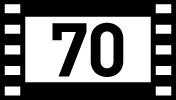

Christopher Nolan brings his supercharged box-office cred and maladroit storytelling skills to this biopic of J. Robert Oppenheimer, the theoretical physicist in charge of developing the first nuclear weapons as part of the Manhattan Project. Working from Kai Bird and Martin J. Sherwin's Pulitzer Prize-winning biography, American Prometheus: The Triumph and Tragedy of J. Robert Oppenheimer (2005), Nolan attempts a big-screen historical epic but ends up with a Cliffs Notes version of history with no shape, color, or texture to bring this stack of factoids to life.
As the film started, I hoped that, for once, writer/director Nolan's penchant for nonlinear narratives might pay off. After all, the story of the Manhattan Project is complex enough, and the Bird/Sherwin book is exhaustively detailed. Nolan's trifurcated narrative unfolds in two parts [a sentence that could only be grammatically correct when employed to describe this filmmaker's approach to screenwriting]. The first timeline is titled “Fusion,” which tells how the Manhattan Project came together in 1942; the second is called “Fission,” which explores how the project participants split apart after the U.S. dropped the bombs on Japan in 1945.
But the movie unfolds from three distinct timelines. In 1954, Oppenheimer (Cillian Murphy), by then known as “The Father of the Atomic Age,” is forced to give testimony before a hostile U.S. Atomic Energy Commission. The hearing has been set up expressly to deny Oppenheimer’s continued security clearance and curtail his credibility with the American public. Then a few years later, in 1959, his political antagonist Lewis Strauss (Robert Downey, Jr.) is sitting for a similarly tense grilling at a Congressional confirmation hearing where he must explain his involvement with Oppenheimer before receiving approval to serve as Commerce Secretary in President Eisenhower's cabinet. But before all these official interrogations really get going, the film presents Oppenheimer’s formative and productive years, in which we see him passionately pursue mentors, colleagues, women, and ideas about physics. Amazingly, the scenes of the men sitting in the hearings are more cinematic than those of young Robert’s interest in volatile science, tempestuous women, and radical politics.
The first forty or so minutes of Oppenheimer are unforgivably written, directed, and edited. Nolan simply strings together stacks of scene fragments at breakneck speed. He casts a cavalcade of famous faces instead of creating characters. He rushes significant people in Oppenheimer’s life on and off screen as if checking off each important figure mentioned in the source material. The disastrous first forty minutes play better when viewed in IMAX, but that's only because you pay less attention to the dialogue when it keeps getting interrupted by IMAX SurroundSound effects and cuts to expansive shots of space, the earth, subatomic particles, and other things the characters reference.
With the introduction of Oppenheimer’s fascinating romantic interest, the American Communist psychiatrist and physician Jean Tatloc (Florence Pugh), we think the film might slow down and breathe a little, giving us some insight into this man as we see him fall in love with an intriguing peer. Nope. The scene where Oppenheimer meets Tatloc is embarrassingly scripted. Even with talents like Murphy and Pugh, the dialogue comes off like two improv actors who’ve been given an audience cue to play a meet-cute scene in the style of an old film noir.
Nolan the screenwriter has always been able to count on Nolan the director to conceal the critical missing elements in his scripts. This feat is accomplished with Nolan’s typical shallow bag of cinematic tricks—overwrought sound mixes that make the dialogue hard to decipher and rapid cuts to faces, vistas, and other imagery that conveys the gist of the dialogue we miss. Everything whizzes by relentlessly, with shots and speeches chopped together by editor Jennifer Lame. Lame has a fantastically uneven track record, editing masterfully constructed films like Manchester by the Sea, Marriage Story, and Judas and the Black Messiah, along with unfocused messes like Tenet, Blonde, and Black Panther: Wakanda Forever. In Oppenheimer, the specifics of the inevitable science-speak, not to mention the characters' motivations, are conveniently submerged under the relentless score of Ludwig Göransson (Creed, Tenet, Turning Red).
It’s not until about minute 42, when Matt Damon shows up playing Brigadier General Leslie R. Groves, Jr., that we get what passes for an actual scene. Groves was the Army Corps of Engineers officer who oversaw the construction of the Pentagon and directed the Manhattan Project. In 1942, Groves talked with Oppenheimer and identified him as the right person to establish the government’s planned new weapons development facility, eventually named Los Alamos Laboratory. Honestly, the main reason this moment, when these two important characters meet, works so well is that both actors can effortlessly bring a level of humanity and entertainment value to roles that are little more than well-worn cinematic clichés—the brilliant, cocky, enigmatic scientist and the blunt, quick-witted, what-ya-see-is-what-ya get military man. Damon is the only actor in this huge ensemble who is given more than one note to play. His Groves is both welcome comic relief and the embodiment of the film’s biggest threat, which is not so much the bomb as the nationalistic mouth-breathers who will choose how to harness its power. Men like Groves, Strauss, and Harry S. Truman (played by Gary Oldman in yet another ridiculous portrayal of a historical figure) are the clear villains of this piece, whereas Oppenheimer is presented as a hero because he expressed regret about how the weapon was used on Hiroshima and Nagasaki and spoke out against its further use.
Since Nolan has no idea what to focus on in telling the story of the development of the Atomic Bomb and its consequences, Oppenheimer seems intended more as a character study than a historical treatise, but I didn’t emerge from the three hours knowing anything more about this man than I knew going in. He’s presented as an enigma whose inner thoughts are conveyed via cutaways to swirling particles and abstract images of neutrons and electrons dancing in his mind. His regrets and fears are telegraphed to us in the last hour via dream-like visuals and some of the film's most awkwardly forced dialogue. While we see him interacting with countless individuals thought the movie, we don’t spend enough time with the people in his life to understand who he was to them—beyond the most banal and shallowest one-sentence summaries. Each character, even his wife (played by Emily Blunt in a thankless role), is a one-dimensional trope.
In Oppenheimer, many notable, talented actors are called upon to bring life to Wikipedia-style summaries of historical figures, and for the most part, they fail, though through no fault of their own. Besides Murphy and Damon, the only exception is Downey’s turn as Lewis Strauss. The performance marks a return to form for the great actor who has been phoning in performances in Marvel movies and silly comedies for the last fifteen years. Oppenheimer is not only Downey’s best performance since he played Paul Avery in Zodiac (2007), but it also marks a new chapter in his career where he can take on the type of elder statesman roles we expect to see played by the likes of Martin Sheen, David Strathairn, or Chris Cooper. Downey deserves the Best Supporting Actor nom he will most assuredly receive for this, but all the focus on his character is also a major part of this picture’s failure.
Nolan uses the Trinity test, the first detonation of a nuclear weapon at the White Sands Proving Grounds in New Mexico, as the centerpiece of this picture. It’s an impressively tense sequence, one of the few that merits the IMAX presentation in terms of its immersive image rather than just the multi-speaker sound. But the sequence feels misplaced within the story’s narrative chronology. The film is meant to examine the consequences of America venturing down the road of splitting the atom, a road you cannot turn back from once you’ve started down it. But for some reason, this epic story of one of the most critical events in the history of civilization builds to a Senate confirmation hearing in which someone who is barely a secondary character in the story of the Atomic Bomb may or may not have his political ambitions forestalled. This climax is some Aaron Sorkin-level bullshit!
The ending of the movie, which features an actual audience cheer moment for Robert Oppenheimer, is the final act of surrender from a screenwriter so incapable of finding a cinematic narrative within the mountain of historical research in his source material that he falls back on the trope of a hundred courtroom dramas and West Wing episodes. It is also why I can say without irony that Oppenheimer is a perfect film for our times. We live in an era where everything is politicized, and electoral politics pollute every aspect of our lives, yet most of the population has zero interest in actively engaging in politics beyond the reality TV aspects of showboating Congressional hearings, WWF-style rallies and “debates,” and the hype that surrounds each and every “most important election of our time,” presidential contest. So, of course, a 2023 movie about one of the most complex and fascinating players ever to cross the world stage will ultimately build to the unimportant drama of whether or not a petty politician survives a public inquest.
I’m sure Oppenheimer is trying to say something new and lofty about how scientists are manipulated by the military-industrial complex and the burden carried by the man most responsible for creating the most devastating weapon of mass destruction ever used on human beings. But I found nothing fresh or illuminating in this film’s 180 minutes. Nolan possesses the unique ability to make long, mature movies with the best actors currently working on the most spectacular format cinema has to offer, and yet this is what he does with all that? The film is written, directed, edited, and photographed like a TV miniseries that got whittled down into feature-length and projected onto a big screen it's unworthy of.
When Quentin Tarantino released his 2015 western The Hateful Eight in 70mm Ultra-Panavision, many people complained that all the hype around resurrecting the thrilling large-scale process and retrofitting hundreds of cinemas to play the movie in its intended format was a colossal waste since the movie was “just a bunch of guys talking in a room.” I begged to differ because so much of what the Ultra-Panavision compositions were capturing in Tarantino’s admittedly subpar chamber piece was how that ensemble of characters squared off inside the confines of that single room. Like My Fair Lady, The Sound of Music, and Ryan's Daughter, The Hateful Eight demonstrates how the 70mm process captures the sharp details of confined spaces just as well as it reproduces sweeping outdoor locations.
But Oppenheimer really is an example of a filmmaker squandering this magnificent format on a movie about a bunch of guys talking in rooms. There isn’t much detail for the large-format cameras to see in sets that are mostly small, flat, grey rooms with nothing on the walls—be they the hastily constructed buildings of Los Alamos or the tiny conference room in which Oppenheimer is confronted by the secret panel of pugnacious Congressmen charged with revoking his security clearance. The few images of sets that could be visually striking, 1940s-era lecture halls, train stations, and science labs, are not held long enough for our eyes to take them in.
Dutch-Swedish cinematographer Hoyte van Hoytema, Nolan’s DP since Interstellar, who also shot Spectre, Ad Astra, and Nope, brings his usual uninspired lensing, which frequently looks so bland you can’t believe it originated off a 70mm or IMAX negative. The picture leaps back and forth between color and black and white and between multiple aspect ratios (if you see the film in an IMAX theater). But these shifts do not translate to a visual feast for the eyes so much as an annoying gimmick. The color and monochrome shifts are motivated by changes in perspective from Oppenhiemer's to Strauss's. But the jumping around from the 2.20:1 aspect 70mm ratio, to the full-frame 1.43:1 IMAX ratio, to what seemed like at least two other ratios, seems to have no rhyme or reason. Nothing prompts these shifts in framing—beyond maybe what "looks coolest"—so we often get these jarring shifts within the same scene! Why? Fortunately, unlike Dunkirk, Interstellar, and The Dark Night movies, there doesn't appear to be a shift in resolution between formats (at least not in digital IMAX but I seemed to detect a shift in celluloid IMAX, though I don't know why since all the footage of these 30 or so prints is supposedly off the original camera negative).
A big deal was made about this picture shooting Black and White IMAX film for the very first time in the history of celluloid. But it’s not like the B&W footage was printed on B&W stock. The cuts back and forth from color to monochrome are too frequent to enable something like what Steven Spielberg and Janusz Kamiński did with Schindler's List (1993), or Woody Allen and Gordon Willis did with Zelig (1983). In those cases, the black and white sequences (for Zelig) and the color sequences (for Schindler’s) were hand-spliced into the bodies of hundreds of show prints, so the true formats were projected in many cinemas. That approach would not be feasible for Nolan’s film with its dozens of edits back and forth, so the whole movie is printed on color stock.
Nolan makes such a big deal about his love of the IMAX format's large negative, its unmatched resolution and its ability to capture finite details. But he and van Hoytema shoot this movie almost the way a documentarian would, with little attention paid to composition, contrast, or depth of field. They light their frames in the most pedestrian manner, usually with what appears to be a single light source. Often, it looks like they just place a big ol' 5K light near one side of a person's face and leave it at that—hardly the best way to showcase the abilities of their chosen medium. Almost every shot in this picture is a close-up of someone talking, a simple two-shot of people in conversation, or a wide shot that instantly cuts to a close-up of someone talking or a simple two-shot of people in conversation. I can only imagine all the hype around the 70mm and IMAX-70mm screenings of Oppenheimer will end up doing the format a disservice. People will emerge from the cinema wondering why they paid extra to see so many close-ups of actors talking in blandly lit, minimally dressed sets. Honestly, both Nolan's visual and narrative approach to Oppenheimer would be more suited to 16mm.
Worse, Nolan’s insistence on releasing a 3-hour IMAX movie taxes the format beyond what it was designed for. IMAX platters—the large tables that hold the reels of film and feed it to the projector—were designed to accommodate a maximum 150-minute film. Nolan, who almost keeps celluloid IMAX alive single-handedly, convinced the company to build larger platters capable of holding the 600-pound, 11 miles long Oppenheimer prints. But dumping these monstrosities in projection booths that haven’t had to run anything like them before, and in many cases that are not staffed by experienced union projectionists working with regularly serviced equipment, is hardly what I consider “keeping the format alive.” All eyes were focused on the success of this release as another movie that could “save Hollywood” even before the “Barbenheimer” social media phenomena that caused all IMAX-70 shows of the opening weekend and beyond to sell out.
As of one week into the release, stories of problem screenings or fully canceled screenings of IMAX-70 (and standard 70mm) shows are all over social media. I’m not sure of the ratio of successful to unsuccessful screenings, but I can give anecdotal evidence that when I drove out of state, paid for parking, and took the prime seat I'd bought four weeks ago for an IMAX-70 screening, I first got an announcement that there would be a 20 min delay. Then came the follow-up bad news: a full cancelation as the projectionist could not get either the film nor digital versions of the movie to play correctly. Apparently, this canceled screening was the first at Road Island’s Showcase Cinema Providence Place. Meaning they ran a whopping 7 or 8 shows before a complete fail, achieving a better record than some of the other 30 cinemas running the format.
But this kind of problem is to be expected when you push a specialty format to its outer limits for a hugely anticipated multiplex summer blockbuster. Nolan’s hubris and ineptitude as a storyteller all but ensured hundreds of dissatisfied IMAX-70 customers. After all, his muddled, simplistic telling of this story does not require three hours.
Christopher Nolan proves to be the only screenwriter who could ever make me long for the subtlety, nuanced understanding of American history, and comedic abilities of Aaron Sorkin.







